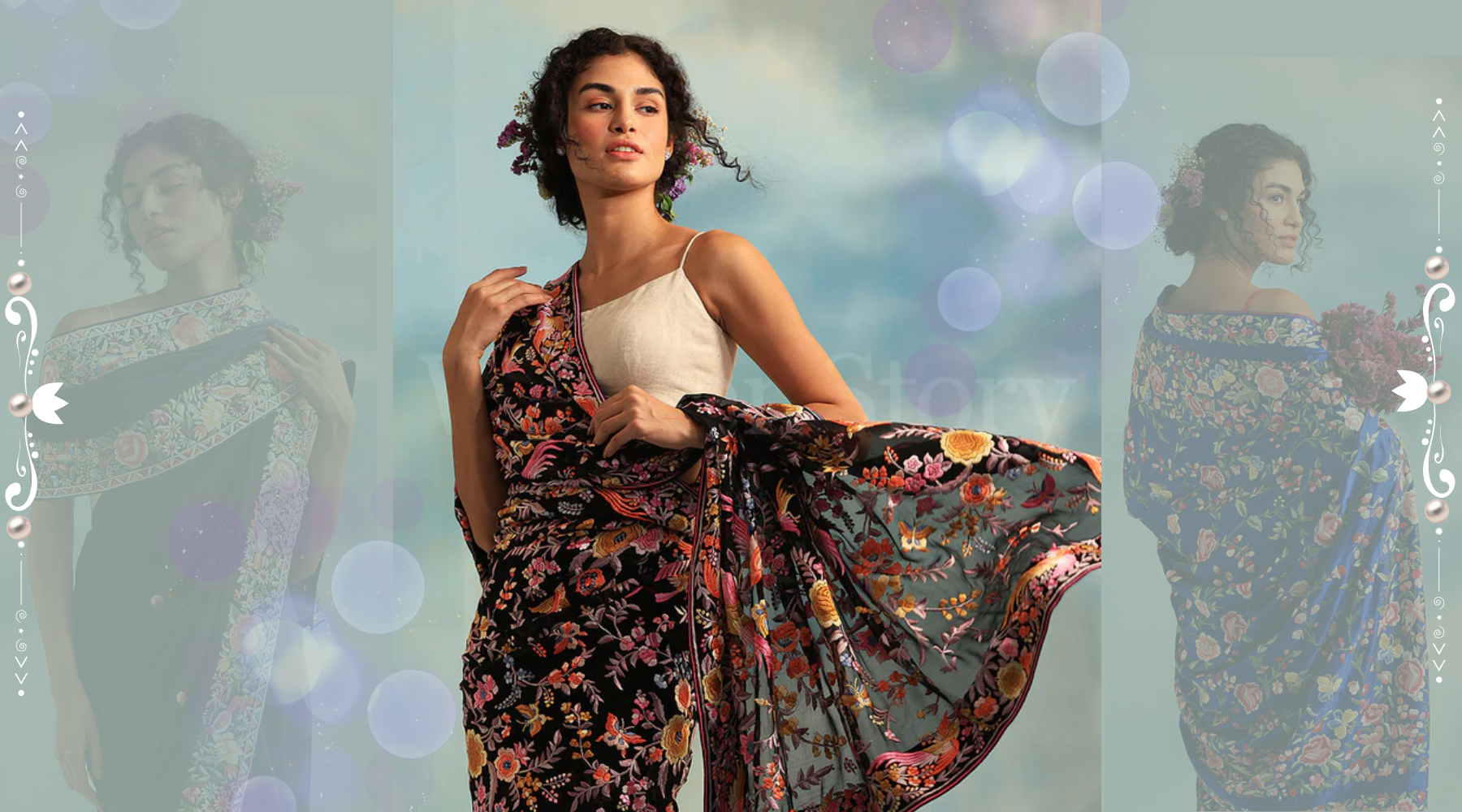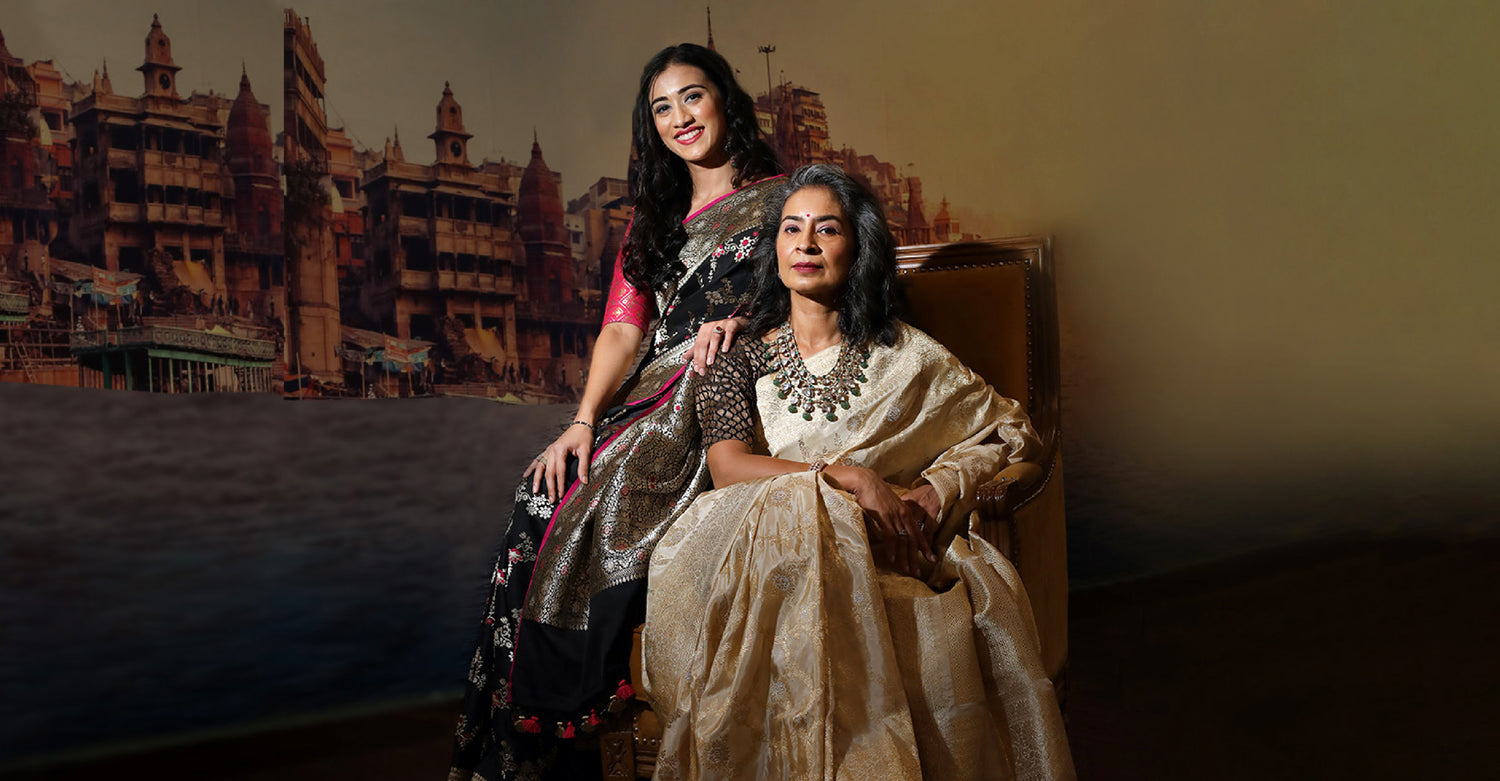Amidst the vibrant tapestry of India’s textile and cultural heritage, one art form that stands out is Parsi Gara Embroidery. With its sheer elegance and intricacy of designs, the Gara embroidery has been passed through generations maintaining its appeal and relevance till today and to date its fascinating origins and exquisite craftsmanship continue to capture our hearts.
Delve into the enchanting world of Parsi Gara embroidery with us, exploring its history, techniques and significance.
WeaverStory’s new collection of Parsi Gara Sarees and accessories brings with it a wave of emotions and regal beauty. It exudes an old world charm on stellar textures in elegant ensembles that are class apart. For a lover of traditional design with contemporary touches and someone who constantly finds ways to be in touch with their roots - Enchanted Garden is an ultra glam collection of fascinating hand embroidered sarees and accessories. Dreamy floral designs on a palette that moves from sunny pastels to jewel tones, each piece is a work of art like a pretty painting on fabric.
A story that goes beyond time: History of Parsi Gara
Intertwined in four different cultures, the roots of Parsi Gara embroidery goes back to the 19th century. When the Parsi community migrated from Persia (now Iran) to India, escaping persecution and for the protection of their identity the ethno religious community found a home in Gujarat. They brought with them unique traditions and styles, widely contributing to a culture in India, already so rich and full of life! From food, music, movies to science and fashion, it was a surreal mix to the community.
When Parsi’s began trading with China they discovered a beautiful silk fabric called - Gaaj. The nature-inspired designs resonated with the merchants who purchased yards of this fabric, and brought it back home. With an enterprising eye for art, their wives started turning these fabrics into sarees and soon, garas, as they came to be called, became an essential symbol of status for the Parsi community. The Chinese designs on these pieces gained popularity. Each one depicting elaborate stories of men and women against backgrounds of pagodas with lanterns, ornamental flowers, phoenix, dragons and beyond. Complementing with royal colours like ruby red, deep blue, emerald green or dark purple that were at the core of this art!
The intricate work and stunning embroideries sought immense value in the community and was considered as a traditional attire for the Parsis, significantly as bridal wear. During the British colonial era, Parsi women outrightly challenged the European dresses with their elegant sarees and dresses embellished with the pleasing Gara embroidery - characterised by vibrant colours, detailed designs, adorned with elegance and grace. An important symbol of the community's identity and artistic expression!
Parsi Gara went out of fashion during the Independence movement when trading stopped with China only to be revived after several years. This is when Indian weavers started hand embroidering thick fabrics with opulent designs - bold peacock motifs, unique floral work, paisleys and abstract art. And the rest was history!
Checkout these Amazingly Embroidered Parsi Gara Sarees From WeaverStory:
Finesse skill and craftsmanship: The making of Parsi Gara
Parsi Gara embroidery is known for its vibrant, bold colours and highly intricate designs deeply inspired by elements of nature. The artistic process of Gara embroidery is a labour of love, requiring immense skill, patience and creativity. Practised only by a handful of craftsmen, they bring to life an array of themes and motifs—from delicate flowers, majestic creatures to mythical birds with their skills, creating visually captivating pieces.
Parsi Gara embroidery is preferably crafted on silk, satin and chiffon for these fine fabrics offer a smooth surface for the work. With time, it found its place on canvases of crepe, georgette and tussar silk, giving an elevated, luxurious look to the attire. The embroidery work is truly a painting in thread, that begins with outline stitches defining the shape of the design and the structure, later filled in using various techniques to complete the pattern. The traditional embroidery is also done using a single thread, often silk which enhances the finesse of the creation
Checkout these Embroidered Parsi Gara Dupattas and Potlis from WeaverStory:
A bridge between traditional and modern: Then and now
With modernisation and the influx of western wear, the Parsi Gara lost its charm during the 80’s. But despite the challenges, it has managed to survive and thrive. The timeless appeal of Parsi Gara adds a unique and elegant element to modern designs, making them stand out. Courtesy the artisans and brands who continue to honour the traditional techniques while incorporating contemporary trends, Parsi Gara ensembles still hold relevance for today’s youth. The preservation and promotion of this art form has been possible due to fashion designers and cultural enthusiasts who have strived to take this art to global platforms.
The cultural legacy of the Parsi community continues with the beauty and craftsmanship of this technique being passed on to generations to come. Parsi Gara embroidery is an important part of their cultural heritage that connects the community to its rich history and traditions.Being an essential element of festivals, celebrations and cultural gatherings, even today, a Parsi wedding is incomplete without the brides adorning a traditionaGara embroidered attire. Beyond sarees, the versatility of Gara embroidery has expanded into various aspects of fashion and home decor. From scarves, stoles, shawls and handbags to cushion covers, wall hangings, and table cloths, this elegant handiwork of artisans gives that final flourish to ensembles and adds touches of regality to homes.
The exquisite embroidery continues to captivate and inspire many, ensuring its place in contemporary artistic expression and cultural preservation. Till today, we cherish this intricate art form that contributes to the rich tapestry of our heritage. The Parsi Gara embroidery is indeed a timeless masterpiece that weaves together threads of history, culture and art. From the shores of Persia to the vibrant streets of India - we celebrate this artistic gem and the new collection by WeaverStory is a testament to its enduring allure and textile heritage. Discover our collection - Enchanted Garden, for lush embroideries, dreamy hues and elegant silhouettes, all coming together to create pieces you would want to own and cherish
Author- Aarushi Sharma













